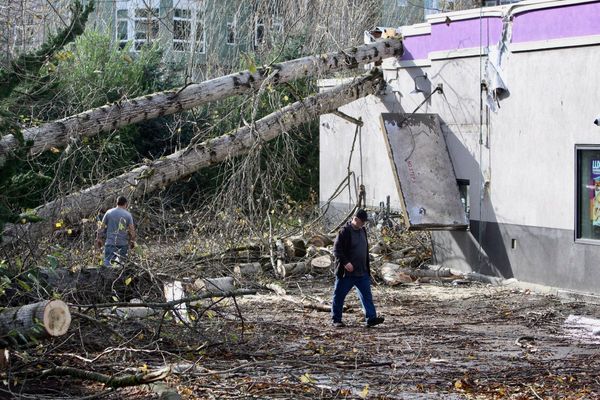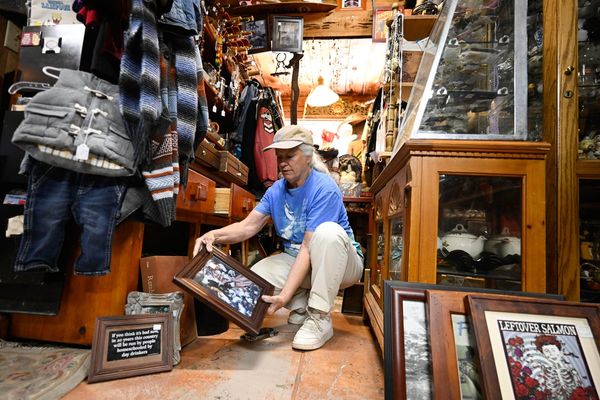
The day after the Eaton Canyon wildfire, still reeling from the destruction of her home and her business, Gaby Murguia scrawled a message on the windows of her truck: “Altadena is not for sale.”
In the month since historically destructive fires raged across Los Angeles, the same slogan has been appearing on posters at local protests, on fliers at restaurants and across new and old social media accounts in the small and racially diverse suburb of Altadena.
Locals here and in neighboring Pasadena are deeply aware of the struggles that residents of Maui and other communities faced in the wake of devastating fires, such as skyrocketing rents, increased evictions and expensive rebuilding efforts that force longtime residents out. Locals say the flames were still raging as people who had just lost their homes started receiving calls from developers.
It’s “plain and simple. I’ve heard it. I’ve said it,” Brandon Lamar, the president of the local branch of the NAACP, said of the slogan. “Everyone that has been displaced – we want them to have the ability to come in and build back. We don’t want price gouging. We don’t want people to come in and try to buy people’s lands.”
Altadena has a proud history of Black homeownership. For decades, it has nurtured Black actors, writers, musicians and activists, while providing a refuge for a racially diverse assortment of creative people who relished their small enclave in the hills north-east of Los Angeles.
The Eaton Canyon fire, which destroyed more than 9,400 structures across Altadena, Pasadena and Sierra Madre, had a disproportionate impact on Black residents in west Altadena, razing nearly half of the Black households in Altadena, according to early estimates from the University of California, Los Angeles (UCLA). A majority of Black homeowners in Altadena are over 65, meaning they are likely to face additional financial and logistical hurdles in the rebuilding process, the UCLA report found.
At least one burned-out plot in Altadena was in the process of being sold this week for a reported $550,000, with the realtor in the deal telling LAist that the previous owner had been renting the property, and “didn’t want to take on the enormous project of rebuilding the home”.
Last Saturday, Murguia and Lamar were both part of a community rally that drew a multiracial crowd of more than 150 people, many wearing different versions of “Altadena is not for sale” T-shirts. Artists set up booths for locals to make paint signs, newly-founded advocacy groups collected contact information from residents affected by the fires, and a drum circle of young artists performed. Murguia, whose embroidery and screen printing business was destroyed in the fire, was working with other local activists to sell T-shirts, and planning to use the proceeds “to fill Altadena with lawn signs to show them we are not selling”, the 30-year-old said.
“Now is the time to come together. Now is not the time to sell,” Anthony McFarland, a local pastor whose home was destroyed, told a cluster of cameras at the rally. If older Black homeowners in Altadena were overwhelmed by the task of rebuilding, he urged them to sell to younger Black and Brown families and maintain the fabric of the community. “Keep it in the family,” he said.
‘Climate gentrification’ concerns
The economic challenges that Altadena’s current residents face in rebuilding are formidable. Jesse Keenan, a Tulane University professor who coined the term “climate gentrification”, said that rebuilding after a big disaster is expensive and comes with major hurdles, such as supply chain disruptions and significant competition for construction, labor and materials. “Even building code officials – there’s barely enough building code officials,” he said.
Rebuilding from scratch usually means that “the cost of housing, and the value of housing, basically doubles,” Keenan said. That can benefit some residents, but it can also result in a community that becomes “unrecognizable or inaccessible to the people who live there”.
There is economic pressure to build condos in place of cheaper multi-family rental units that were damaged or destroyed. And even if rental units are built back in similar quantities, he said, prices tend to rise: rebuilt, an older apartment unit that once rented for $1,000 will cost $3,000 or $4,000.
California governor, Gavin Newsom, quickly issued executive orders banning price-gouging for rent in the wake of the fires and attempting to block developers from making under-market offers for properties in fire-damaged areas.
But trying to counteract the broader economic pressures that make rebuilt housing more expensive is “a massive effort of civil society”, Keenan said. In order to rebuild a community and keep it affordable, “You need a multi-sector coordinated effort between the public sector, philanthropy, community development finance institutions, non-profit housing developers and the state, in terms of permitting,” he said. “Basically, it requires subsidy.”
This kind of coordinated effort also needs to happen quickly, Keenan said. The faster that people rebuild, “the more likely that the community will be more or less intact”, he said. “The longer it takes for people to rebuild, the more likely it is that people give up, sell, pay off their mortgages with the insurance proceeds.”
Doing all of this in Los Angeles, which already has a very expensive housing market and is one of the epicenters of California’s long-running housing shortage crisis, will be extremely difficult, he added.
Meanwhile, real estate developers with enormous financial resources will be standing by, ready to buy up properties that individual owners are struggling to rebuild, said Stephanie Pincetl, the director of the California Center for Sustainable Communities at the University of California, Los Angeles.
“Equity capital is already doing a lot of financialized development, and they’re not going to stop,” she said. “This is an enormously profitable opportunity.”
While homeowners tend to be the focus of post-disaster assistance efforts, Los Angeles renters are also likely to struggle for years to come. The sudden destruction of so many homes has cascading effects on rental markets, said Justin Steil, an urban planning expert at the Massachusetts Institute of Technology.
“Climate disasters are associated with a significant increase in rents after the disaster, especially for the lowest income renters,” Steil said. Researchers have also found an increase in evictions not only in the year of the disaster itself, but also the year following. “In places where the median rents are already higher, the increase in evictions is larger,” Steil said.
Even before these fires, Altadena had struggled with years of gentrification that had made housing there increasingly unaffordable, and decreased the town’s proportion of Black homeowners. In 1980, 43% of the town’s residents were Black, while today, that number is just 17%, according to the UCLA report.
Recent statistics showed that many Black households in the town were already paying a disproportionate amount of their income on housing costs, and that Black applicants made up only 4% of those trying to buy homes in Altadena in 2023.
Now, the threat of post-fire gentrification “is probably one of the top three concerns amongst people here,” said Michael Williams, 31, a Black Lives Matter Los Angeles organizer and third-generation Pasadena resident who estimates that more than 30 people he knows lost their homes in the blaze, most of them Black.
‘Keep Altadena the Black center it has been’
While homeowners whose houses were destroyed have to make individual decisions about whether to sell or to try to rebuild, the outcome of their choices will be deeply shaped by what their neighbors do.
“I was just talking to someone that I know who had lost their home, and they were like, ‘I want to rebuild, but I don’t know if my neighbours or folks around me want to rebuild. I don’t want to rebuild in a neighborhood that’s going to be either parking lots, or apartment buildings, and being the only home there,’” Williams said.
He and other advocates have been working together to host frank community discussions on the challenges of rebuilding and the resources available to them, including the possibility of creating land trusts to allow residents to sell their property to others within the community. The goal, he said, is “to keep Altadena the Black center it has been”.
It’s not just those who lost their homes who have to decide whether to stay in the community as it rebuilds, Williams added. The threat of wildfires is not going away. Williams, his parents, who are in their 60s, and his 100-year-old grandmother all had to evacuate their homes in Pasadena during the Eaton Canyon fire. The ordeal, and its long aftermath, have been particularly difficult for his grandmother, who has had to remember to wear a mask outside, and that it’s not currently safe to drink the water from her tap.
His mother and father “are trying to find ways to stay, but also thinking about what their options are”, Williams said. “We don’t know if this will happen again next year, or how bad it will be if it happens again.”
“Those are questions that everyone has to ask,” he added. “Even if we do decide to stay, what changes in the way we live do we have to make in order to protect ourselves?”
For small business owners, the displacement of local residents in the wake of the fire creates additional challenges. Geoff Cathcart, 48, a barber, lost his home in the fire, but his Altadena-based barbershop, Lawrence and Colbert, survived. But Cathcart’s customers are currently scattered to many different locations, he said, and he knows recovery “is going to be a long process”.
Still, he showed up to Saturday’s community rally, determined to work to preserve the local culture. “This is one of the few predominantly black communities in southern California that still has a hometown feel,” he said.
The importance of community spirit and local organizing should not be underestimated, said Keenan, the climate gentrification researcher.
After the major earthquake and tsunami in Japan in 2011, the government opened community centers in affected areas, which hosted programming and “brought people of different ages and backgrounds to be in dialogue”.
“Little things like that add up,” he said. “It sounds very soft, the emotional healing that comes along with community … but it’s really important, and we know it’s important.”







